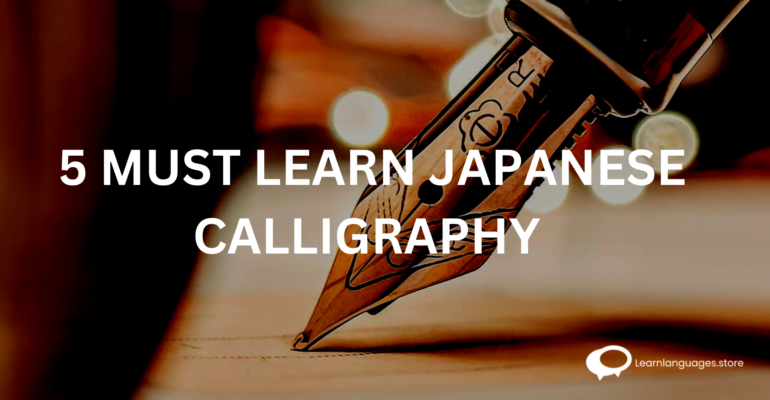5 Must Learn Japanese Calligraphy
5 Must Learn Japanese Calligraphy
The exquisite and expressive nature of Japanese calligraphy has made it a popular art form historically and culturally, inspiring interest in learning more about it. Learn Japanese Language
It is a cutting-edge art form that everyone can practise. It is also referred to as shodo Japanese calligraphy, which is artistically expressed by various brushstrokes. Writing, however, can take on any form and typically entails the use of inked symbols to create a communication. The art of Japanese calligraphy has been passed down from generation to generation, stressing harmonious and lovely lettering. We shall cover every aspect of Japanese calligraphy styles and their various varieties in this essay.

Japanese Calligraphy: What Is It?
You’ve come to the right site if you’re curious what calligraphy is. Different forms of visual art are connected to writing. It contains lettering that is created with a pen or an ink brush for communication. It is referred to as a legitimate creative discipline that demonstrates the current development of the lettering craft and supports it with contemporary examples.
Japanese calligraphy is the art of calligraphy writing styles, which uses inks and brush strokes to produce various letters and symbols. One of the most effective ways of communicating that highlights the elegance of writing is this. However, bamboo brushes and The soot of pine trees and various vegetable sources are used to create the Sumi ink. So let’s start and find out more about its beginning! If you’re interested in learning more about japanese.
The Origins and History of Japanese Calligraphy
Japanese calligraphy has its roots in Chinese calligraphy from the Han Dynasty, which Buddhist monks introduced to Japan in the sixth century AD.
Japan at the time had a spoken language but no official writing system. It was at this time that Japan began to adapt various calligraphy styles from Chinese languages to reflect the Japanese language. However, it was a protracted procedure that required several millennia.
One of the most popular calligraphy languages used by the populace is kanji, which later took on distinctive forms. The original creator of true Japanese calligraphic forms is Ono no Michikaze. Japanese letters developed throughout the Heian era, which lasted from 792-1185, and new character kinds, such as Kana, were created. It was a brand-new product to the Japanese calligraphy paper line. True calligraphy is best practised by putting your heart and soul into the task and writing with passion. It will convey the artist’s strong feelings, enthusiasm, and individuality. Learn Japanese
5 Various Shodo Writing Formats
Numerous Japanese letterings have developed since the start of Japanese calligraphy, reflecting various eras. However, each calligrapher has their own unique manner of innovatingly expressing their style, even though some arts are said to be identical to Japanese calligraphy. The top 5 Japanese calligraphy sets that you need to know are shown below:

Kaisho
Kaisho is the first thing you must learn if you want to study Japanese calligraphy. The core of the craft is writing in a block format. Correctness, symbolised by the letter kai in the word “kaisho,” is what the phrase is all about. Each brushstroke is executed according to a predetermined order, and the composition and proportions are accurate. Once they master kaoshi, artists can simply transition to other types of art.
Gyosho
Kaisho is more rigid and formal; Gyosho is less so. It is known as a semi-cursive script and is used in daily handwriting. The strokes are allowed to overlap in this style of calligraphy, giving the characters a less angular and more round and fluid appearance. In addition, the Japanese writing style requires that each stroke be followed by the next without the brush ever leaving the page. As a result, it is a popular choice among writers and among painters.
Sosho
One of the most difficult forms of Japanese calligraphy symbols to master and comprehend is sosho. Characters overlap in this cursive writing style, which mimics the effect of wind-blown grass. In this type of calligraphy, strokes are changed and occasionally eliminated to make the connections between the symbols more fluid. It is extensively utilised in abstract art, including Zen art, where it is necessary to transport energy throughout the piece.
Tensho
The earliest known example of calligraphy is Tensho, which dates back to a time when paper and ink were invented. Because it was employed to create seals for imprinting impressions onto other materials, it is also known as a “seal script.” Apart from that, it is still applied to several seals in Japan today.
Reisho
In contrast to Tensho, Reisho is a practical and efficient writing style. The phrase “the scribe’s script” describes it. Ink was used to create this type of lettering on strips of wood or bamboo. The intriguing aspect is that it continues to appear on Japanese currencies.

Writing Japanese Calligraphy: 3 Tips
Are you interested in learning calligraphy? Not to worry! We are outlining the top methods for instructing beginners in the Shodo writing style. One of the distinctive art forms, each spin item is unique. Here are the perfect tips to keep in mind before starting started with Japanese calligraphy:
Brush Movements
In terms of brushes, Japanese calligraphy uses a variety. In Kanji, there are eight strokes known as eijihappo. But before using the brush, one must grasp the search stroke. The usage of brushes are as follows:
Learn Japanese
Japanese brushstrokes employ type ten dots.
- Yokoga
- Vertical stroke
- Vertical Tatega stroke
- from a horizontal or vertical stroke, Hane Upflick
- Rightward upflick Migihane
- Hidaribarai Downstroke to the left
- Hidarihane
- Rightward downswing
- Rightward downstroke Migibarai
Brush Holding Techniques
For calligraphers, there are many different methods to hold the brush. The index finger, thumb, and middle finger are used to hold the brush when utilising the Tankoho technique. While using the Sokoho technique, the artists also held the brush in their ring finger. Learn Japanese
choice of paper
Paper Options Different sorts of paper options are now readily available as a result of modernization. White paper is typically used for writing Kanji, while letter paper is used for brush writing or making customised letters. However, calligraphers can select from a broad variety of hues, designs, and paper weights.

conclusion
Japanese calligraphy is another culture that was introduced to Japan, just like other Japanese arts and antiques. In Japan, where they have developed their distinctive styles, it is one of the customs that is widely used. Today, it is one of the most highly regarded and admired artistic disciplines! We sincerely hope that this article encourages you to start learning Japanese calligraphy. Join our Japanese class, either in-person or online, to improve your language skills.
Learn Languages Store
Vashi,
Email: services@learnlanguages.store








